Step into the world of Scandinavian kitchen design, where form and function dance in perfect harmony. This Nordic-inspired aesthetic has captivated homeowners and designers alike with its understated elegance and pragmatic approach to living.
Rooted in the principles of simplicity, functionality, and connection to nature, Scandinavian kitchens offer a respite from the cacophony of modern life. They’re characterized by clean lines, light-filled spaces, and a judicious use of natural materials that create an ambiance both serene and inviting.
Whether you’re planning a complete kitchen overhaul or simply looking to infuse your space with some Nordic charm, this curated collection of 30 Scandinavian kitchen ideas will serve as your lodestar.
From minimalist cabinetry to hygge-inspired nooks, we’ll explore how to create a kitchen that’s not just a place for culinary endeavors, but a sanctuary for daily living.
Scandinavian Kitchen Ideas
So, grab a cup of coffee, and let’s embark on this Scandinavian design journey together.
1. Embrace White Walls

White walls are a hallmark of Scandinavian interiors, and for good reason. They create a bright, airy atmosphere that makes even the smallest kitchens feel spacious and inviting. The pristine white backdrop serves as a perfect canvas for other design elements, allowing furniture, fixtures, and accessories to stand out.
To prevent the space from feeling sterile, consider incorporating different shades of white or adding subtle texture to the walls. Techniques like limewashing or using matte paint finishes can add depth and interest while maintaining the clean, fresh look that Scandinavian design is known for.
2. Incorporate Natural Wood

Natural wood is an essential element in Scandinavian kitchen design, adding warmth and texture to the space. Light-colored woods like birch, ash, and pine are particularly popular choices that complement the bright, airy feel of Nordic interiors.
Consider incorporating wood through open shelving, countertops, or even a stunning wooden island. For a more subtle approach, opt for wooden bar stools or a rustic dining table. The key is to balance the wood elements with other materials to create a harmonious and inviting atmosphere that embodies the Scandinavian ethos of bringing nature indoors.
3. Open Shelving for Display and Storage

Open shelving is a quintessential feature of Scandinavian kitchens, offering both practical storage and an opportunity to display your favorite items. This design choice not only makes your kitchen feel more open and spacious but also encourages a minimalist approach to your belongings.
Opt for simple, streamlined shelves in light wood or white to maintain the airy feel of your kitchen. Use these shelves to showcase beautiful ceramics, cookbooks, or plants, adding personality to your space while keeping everyday items within easy reach. Remember to keep the displays curated and uncluttered to maintain the serene Scandinavian aesthetic.
Pro Tip: Address noise issues in your kitchen with decorative acoustic panels that double as minimalist wall art, adhering to Scandinavian functionality principles.
4. Pendant Lighting as a Focal Point
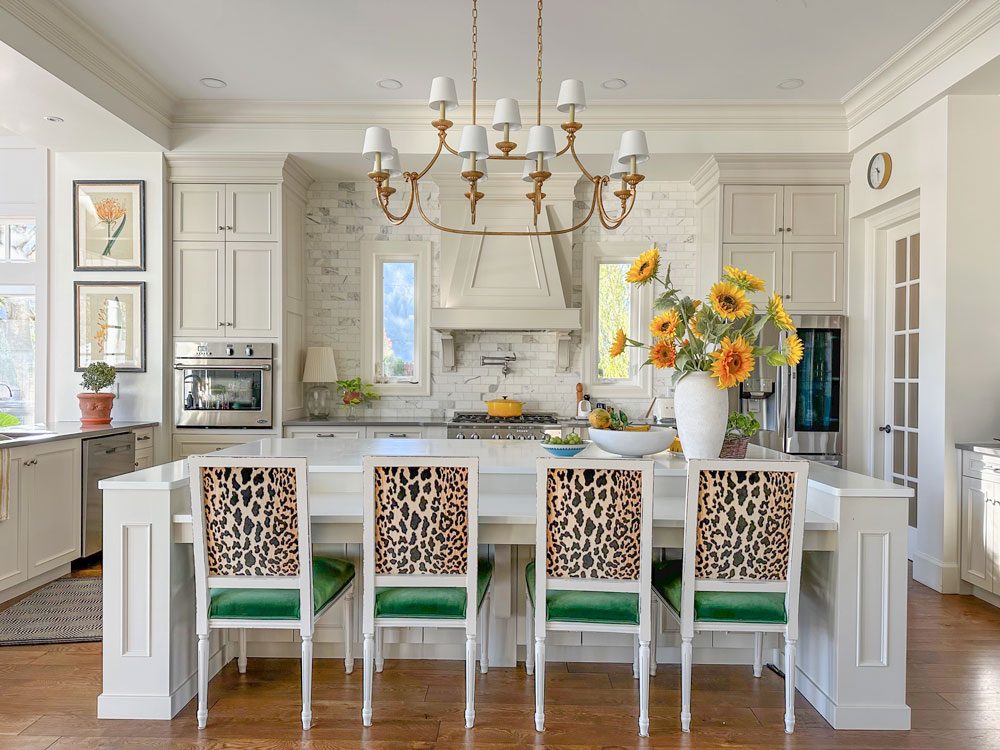
Lighting plays a crucial role in Scandinavian design, and pendant lights are an excellent way to add both functionality and style to your kitchen. Choose sleek, minimalist designs in materials like metal, glass, or wood to create a striking focal point above your island or dining area.
Consider opting for pendant lights with warm-toned bulbs to create a cozy ambiance, especially important during long Nordic winters. For a more dramatic effect, hang a cluster of pendants at varying heights. Remember that in Scandinavian design, form follows function, so ensure your lighting choices provide ample illumination for cooking and dining tasks.
5. Monochromatic Color Scheme

A monochromatic color scheme is a hallmark of Scandinavian design, creating a sense of calm and cohesion in the kitchen. While white is often the dominant color, don’t be afraid to experiment with shades of gray, beige, or even soft pastels.
To keep the monochromatic look interesting, play with different textures and materials. For example, pair smooth white cabinets with a textured backsplash in a slightly different shade. Add depth by incorporating various tones of the same color throughout the space, from the walls to the accessories. This approach creates a sophisticated, unified look that’s both timeless and tranquil.
6. Sleek, Handle-less Cabinets

Sleek, handle-less cabinets are a popular choice in Scandinavian kitchens, contributing to the clean, uncluttered aesthetic. These cabinets create smooth, uninterrupted lines that enhance the sense of space and simplicity in your kitchen.
Opt for push-to-open mechanisms or recessed handles to maintain the minimalist look. Choose light colors like white, light gray, or pale wood finishes to keep the space bright and airy. For a more contemporary twist, consider mixing handle-less upper cabinets with lower cabinets featuring subtle, streamlined handles.
7. Contrasting Black Accents
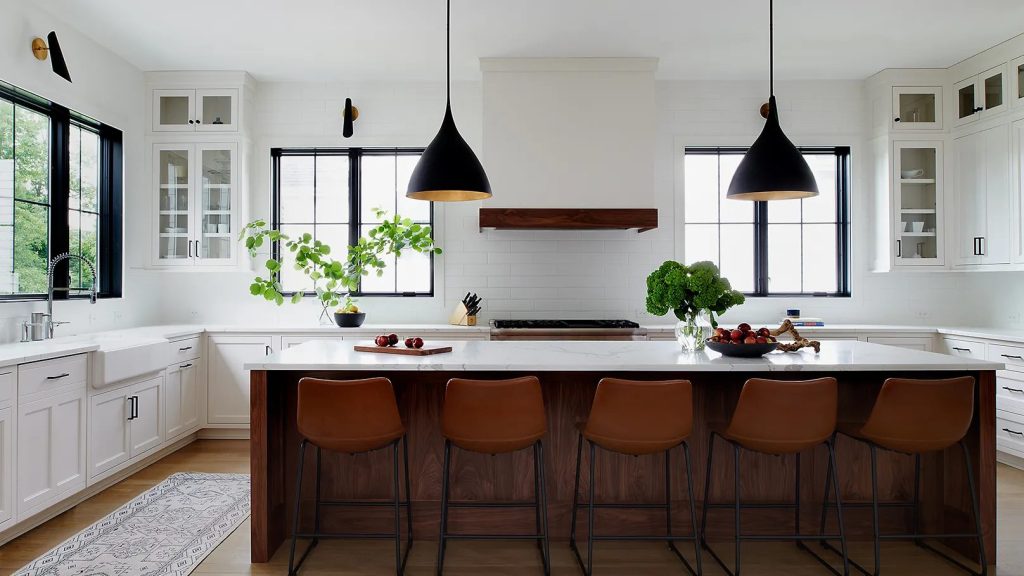
While Scandinavian design is known for its light and bright spaces, introducing black accents can add depth and sophistication to your kitchen. These contrasting elements create visual interest and prevent the space from feeling too sterile or one-dimensional.
Consider incorporating black through hardware, light fixtures, or even a statement appliance like a sleek black refrigerator. For a bolder approach, you might opt for black countertops or a black backsplash to create a striking contrast against white cabinets. Remember to use black sparingly to maintain the overall light and airy feel of your Scandinavian kitchen.
Related Guide: 30 Nightstand Decor Ideas to Transform Your Bedroom
8. Bring in Greenery

Incorporating plants and greenery is an essential aspect of Scandinavian design, bringing life and a connection to nature into your kitchen. In a region known for long, dark winters, the presence of plants helps create a fresh, vibrant atmosphere year-round.
Choose low-maintenance plants that thrive in indoor conditions, such as succulents, pothos, or herbs. Display them in simple, minimalist pots on open shelves, windowsills, or hanging planters. For a more dramatic effect, consider a vertical herb garden or a large statement plant in a corner. The key is to balance the greenery with the clean lines and neutral palette of your Scandinavian kitchen.
9. Functional Minimalism

Functional minimalism is at the core of Scandinavian design philosophy. In the kitchen, this translates to a space that is both beautiful and highly practical, free from unnecessary clutter and ornamentation.
Focus on keeping countertops clear and storing items out of sight in well-organized cabinets and drawers. Choose multi-functional pieces and appliances that serve multiple purposes to maximize efficiency. When selecting decorative items, opt for pieces that are both aesthetically pleasing and useful, such as a beautiful wooden cutting board or a sleek, modern kettle.
10. Mixed Materials for Texture

While Scandinavian design often emphasizes simplicity, incorporating a mix of materials can add depth and interest to your kitchen. The key is to balance different textures and finishes in a harmonious way that doesn’t overwhelm the space.
Consider combining smooth, matte cabinets with a textured backsplash or countertop. Pair sleek stainless steel appliances with warm wooden elements. Introduce textured fabrics through window treatments or seat cushions. The goal is to create a layered, inviting space that engages the senses while maintaining the overall clean and uncluttered Scandinavian aesthetic.
11. Subway Tile with a Twist
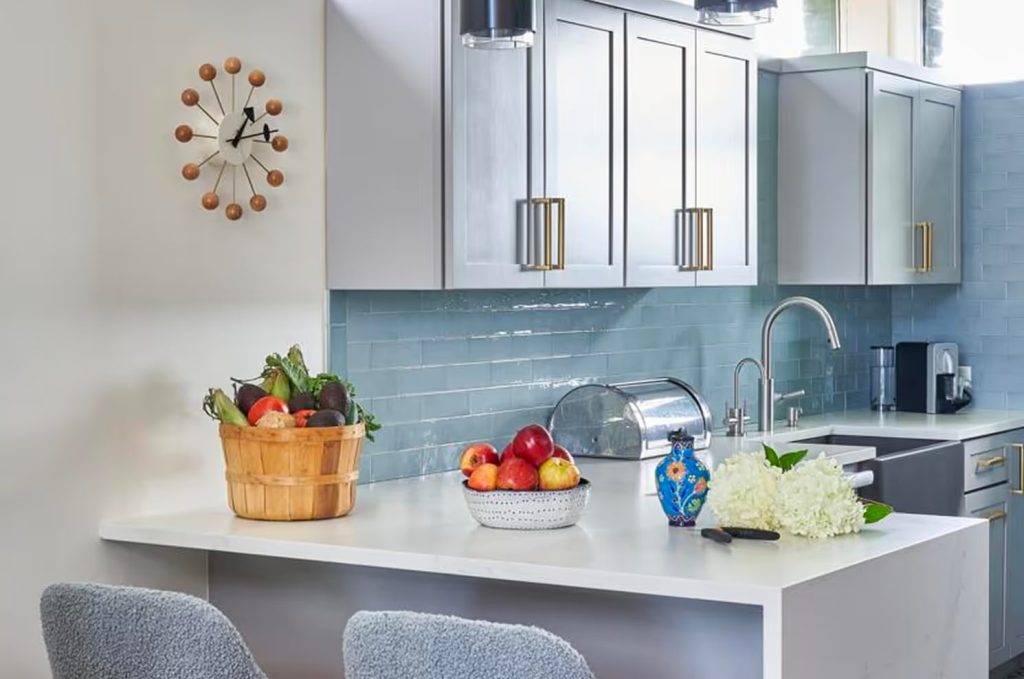
Subway tiles are a versatile choice that fits perfectly with Scandinavian kitchen design. While classic white subway tiles are always a safe bet, consider giving this timeless element a Nordic twist by experimenting with different layouts or colors.
Try a herringbone pattern for added visual interest, or opt for soft gray or pale blue tiles to introduce a subtle hint of color. For a more dramatic effect, consider using dark grout with white tiles to create a striking contrast. Remember to keep the overall look clean and simple, allowing the tile pattern to serve as a subtle design feature rather than an overwhelming element.
12. Cozy Dining Nook

A cozy dining nook is an essential element in many Scandinavian kitchens, embodying the concept of “hygge” – a Danish term for a mood of coziness and comfortable conviviality. This space serves as a gathering spot for family meals, casual conversations, or a quiet cup of coffee.
Create your nook with a simple wooden table and chairs, or opt for a built-in bench along one wall to maximize space. Add comfort with plush cushions and throws in neutral tones or subtle patterns. Consider placing the nook near a window to take advantage of natural light, making it a perfect spot for both morning breakfasts and intimate dinners.
13. Statement Range Hood

While Scandinavian design emphasizes simplicity, a statement range hood can serve as a striking focal point in your kitchen without overwhelming the space. Choose a sleek, minimalist design that complements the overall aesthetic of your kitchen.
Consider a stainless steel hood for a modern, industrial touch, or opt for a white or black model to blend with or contrast against your cabinetry. For a more unique approach, a copper or brass hood can add warmth and character to your kitchen. Remember that the range hood should be both visually appealing and highly functional, efficiently removing cooking odors and steam.
14. Glass-Front Cabinets
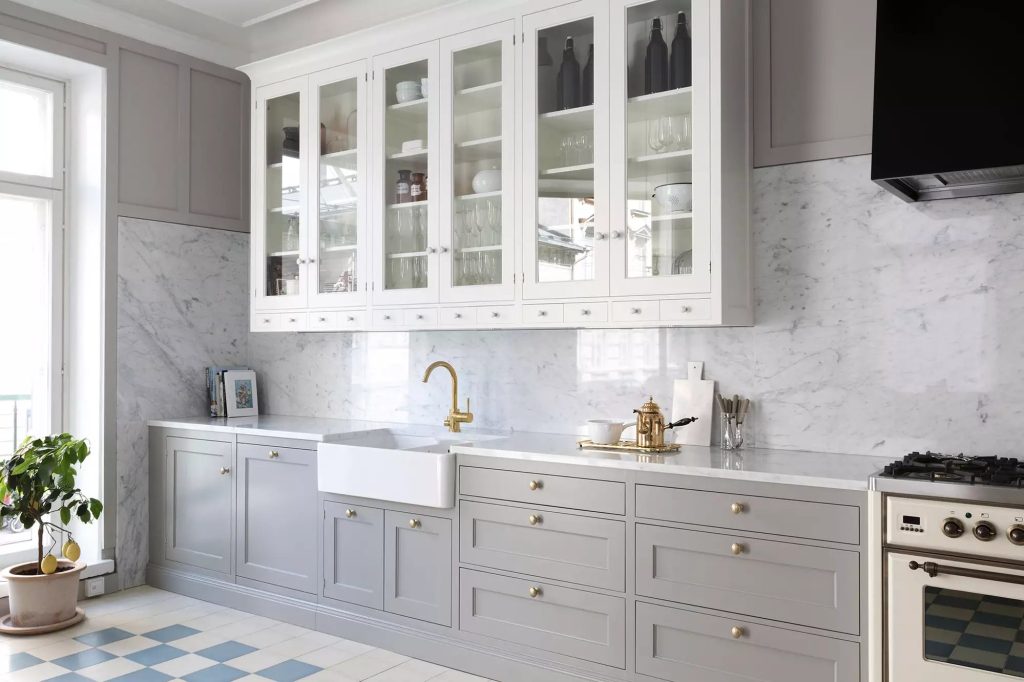
Glass-front cabinets are a popular feature in Scandinavian kitchens, offering a perfect balance between open shelving and closed storage. They allow you to display your favorite dishes or glassware while keeping them protected from dust and kitchen splatters.
Opt for cabinets with simple, frameless glass doors to maintain a clean, modern look. Use these cabinets to showcase white ceramics, clear glassware, or carefully curated collections that add personality to your kitchen. For a more subtle approach, consider frosted glass which provides a hint of what’s inside while maintaining a clean, uniform appearance.
15. Neutral Flooring Choices
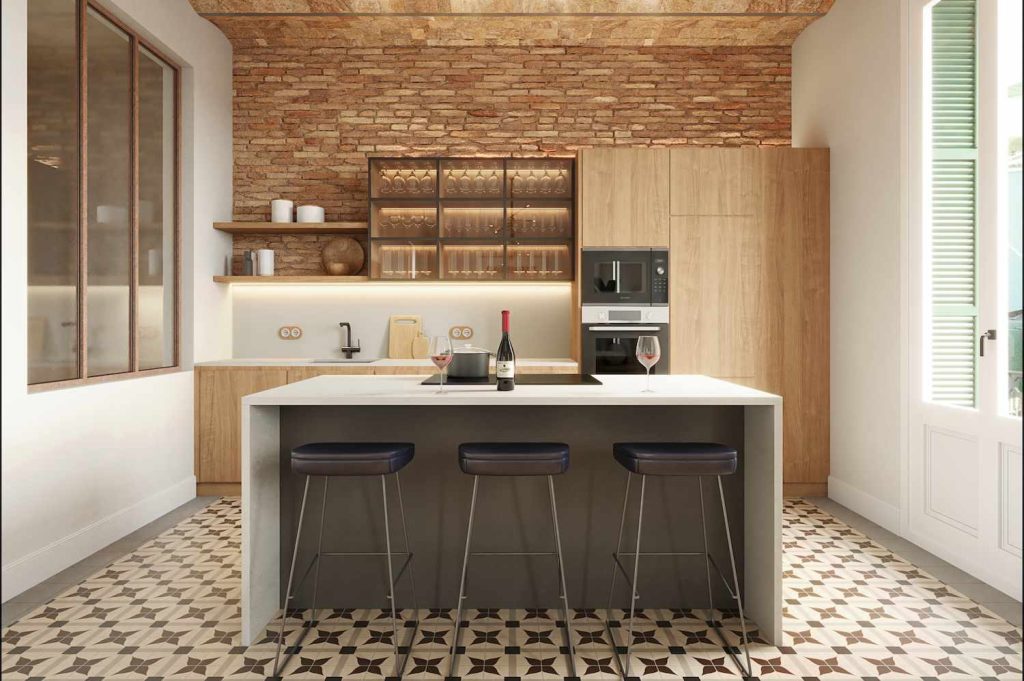
Flooring plays a crucial role in Scandinavian kitchen design, providing a foundation for the entire space. Opt for neutral, light-colored flooring to enhance the bright, airy feel of your kitchen.
Light wooden floors are a classic choice, offering warmth and natural beauty. Consider wide planks in oak, ash, or pine for an authentic Scandinavian look. For a more durable option, light-colored tiles or polished concrete can provide a similar aesthetic while being easier to maintain. If you prefer a softer look, consider pale gray or beige tiles that mimic the appearance of natural stone.
16. Clever Storage Solutions

Efficient storage is a hallmark of Scandinavian design, where every item has its place. Incorporate clever storage solutions to keep your kitchen organized and clutter-free, enhancing both functionality and aesthetic appeal.
Consider pull-out pantry shelves, deep drawers with internal organizers, or a dedicated appliance garage to keep countertops clear. Utilize vertical space with tall cabinets or a pegboard wall for hanging utensils and small items. Don’t forget about often-overlooked areas like the space above the refrigerator or the sides of cabinets, which can be fitted with slim pull-out storage units.
17. Textured Backsplash

While Scandinavian design often favors smooth, clean surfaces, a textured backsplash can add depth and interest to your kitchen without compromising the overall minimalist aesthetic. This element can serve as a subtle focal point, breaking up the uniformity of sleek cabinets and countertops.
Consider options like 3D tiles in geometric patterns, textured ceramic tiles, or even a backsplash made from natural materials like stone or wood. Keep the color palette neutral – whites, grays, or soft earth tones work well. The texture should be noticeable but not overwhelming, adding a layer of visual interest that complements rather than competes with other elements in your kitchen.
18. Scandinavian-Inspired Artwork
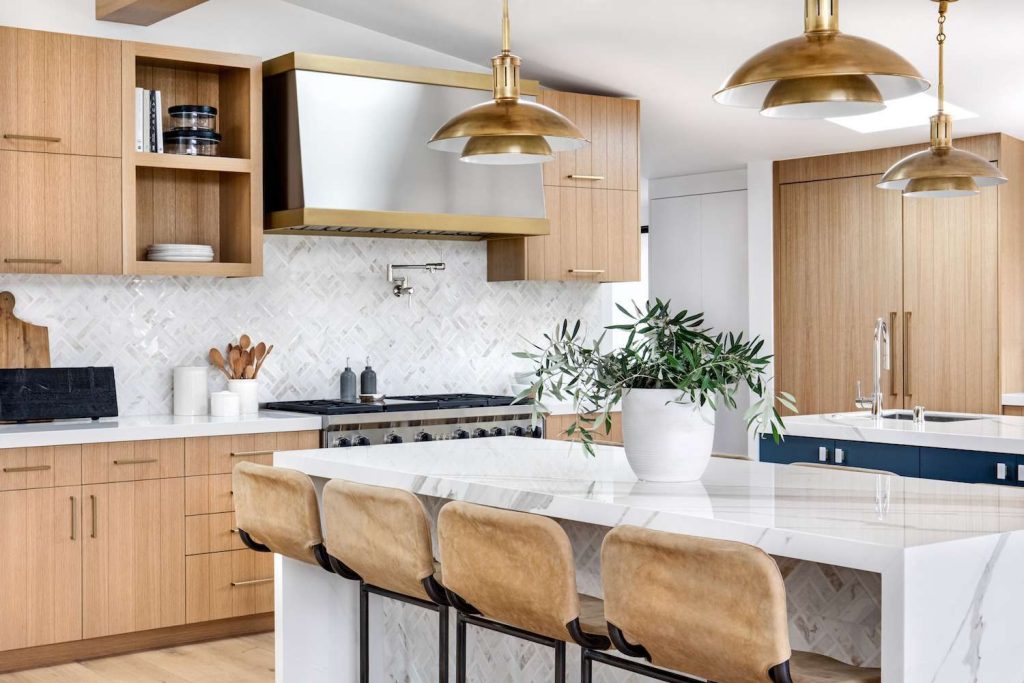
Incorporating artwork into your Scandinavian kitchen adds personality and visual interest while maintaining the clean, uncluttered aesthetic. Choose pieces that reflect the simplicity and nature-inspired themes common in Nordic design.
Consider black and white photographs of landscapes, minimalist line drawings, or abstract pieces in muted colors. Framed botanical prints or simple, graphic posters can also work well. Limit yourself to one or two statement pieces rather than cluttering walls with multiple small artworks. Remember, in Scandinavian design, less is often more – let your chosen artwork stand out against the clean backdrop of your kitchen.
19. Copper Accents for Warmth

While Scandinavian design often leans towards cooler tones, incorporating copper accents can add a touch of warmth and luxury to your kitchen. Copper’s rich, rosy hue provides a beautiful contrast to the typical white and wood elements of Nordic interiors.
Consider copper pendant lights, a set of copper pots and pans displayed on open shelving, or copper cabinet hardware. For a more subtle approach, incorporate small copper accessories like a kettle or utensil holder. The key is to use copper sparingly as an accent, allowing it to add a touch of warmth without overwhelming the clean, minimalist aesthetic of your Scandinavian kitchen.
Note: For countertops or flooring, consider light-colored concrete with a subtle tint to add warmth while maintaining the minimalist look.
20. Integrated Appliances

Integrated appliances are a popular choice in Scandinavian kitchens, contributing to the clean, uncluttered look that defines Nordic design. By concealing appliances behind cabinet fronts, you create a seamless, cohesive appearance that enhances the sense of space and simplicity in your kitchen.
Consider integrating your refrigerator, dishwasher, and even smaller appliances like microwaves or coffee makers. This approach not only creates a sleek, uniform look but also allows the natural materials and intentional design elements of your kitchen to take center stage. When choosing appliances, opt for energy-efficient models to align with the Scandinavian emphasis on sustainability and functionality.
21. Rustic Elements

While Scandinavian design is often associated with modern minimalism, incorporating rustic elements can add character and warmth to your kitchen. This approach creates a balanced space that feels both contemporary and cozy.
Consider adding a farmhouse sink, open shelving made from reclaimed wood, or a vintage wooden dining table. Exposed wooden beams on the ceiling can add architectural interest and a touch of rustic charm. The key is to balance these elements with the clean lines and simplicity of Scandinavian design, creating a space that feels both fresh and lived-in.
22. Minimalist Hardware

In Scandinavian kitchen design, even the smallest details matter. Choosing minimalist hardware for your cabinets and drawers can significantly contribute to the overall clean, uncluttered aesthetic.
Opt for simple, streamlined handles in materials like brushed nickel, matte black, or even leather pulls for a touch of unexpected texture. For an ultra-minimalist look, consider push-to-open mechanisms that eliminate the need for visible hardware altogether. Remember, the goal is to create a cohesive look where every element, no matter how small, contributes to the overall design without drawing unnecessary attention.
23. Light Wood Flooring

Light wood flooring is a quintessential element of Scandinavian kitchen design, bringing natural warmth and brightness to the space. This flooring choice helps to reflect light, making your kitchen feel more spacious and airy.
Opt for wide planks in light-colored woods like ash, birch, or light oak. The natural grain patterns add subtle texture and interest without overwhelming the space. Consider a matte or low-sheen finish to maintain the organic, understated look typical of Scandinavian interiors. If real wood isn’t practical for your space, high-quality laminate or luxury vinyl planks in light wood tones can provide a similar aesthetic with added durability.
24. Functional Island with Seating

A functional island with seating is a versatile addition to any Scandinavian kitchen, serving as a prep area, dining space, and social hub. This multifunctional element embodies the Nordic principle of combining beauty with practicality.
Choose an island design that complements your kitchen’s overall aesthetic, whether that’s a sleek, all-white model or one that incorporates warm wood tones. Add comfortable bar stools in simple, streamlined designs. Consider incorporating storage into your island with drawers or open shelving. For added functionality, you might include a sink or cooktop in the island, making it a true workhorse in your kitchen.
25. Soft, Muted Color Palette
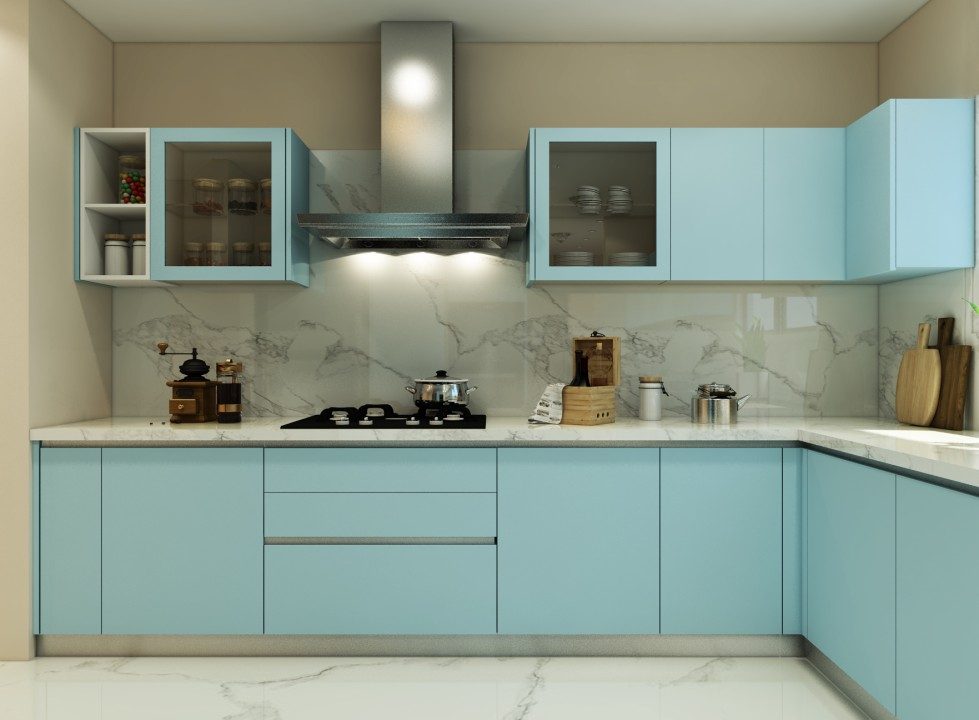
While white is often the dominant color in Scandinavian kitchens, incorporating a soft, muted color palette can add depth and interest to your space without compromising the bright, airy feel. This approach allows you to infuse personality into your kitchen while maintaining the serene atmosphere characteristic of Nordic design.
Consider pale blues, soft greens, or muted grays for cabinetry or a feature wall. These colors work beautifully with the light woods and white elements typical of Scandinavian interiors. Remember to use color sparingly – the overall effect should be subtle and calming rather than bold or overwhelming.
26. Mix of Open and Closed Storage

A mix of open and closed storage is a hallmark of Scandinavian kitchen design, offering both practical organization and opportunities for display. This combination allows you to keep essentials hidden away while showcasing your favorite items, creating a space that’s both functional and visually appealing.
Use closed cabinets for storing everyday items and appliances, keeping countertops clear and uncluttered. Incorporate open shelving to display beautiful dishes, cookbooks, or decorative objects that add personality to your kitchen. Consider glass-front cabinets as a middle ground, allowing you to show off items while keeping them dust-free. The key is to strike a balance, maintaining the clean lines and organized feel of Scandinavian design while adding touches of warmth and individuality.
Related Guide: 45 Creative Japandi Bedroom Ideas
27. Natural Stone Countertops

Natural stone countertops bring an element of organic elegance to Scandinavian kitchens, adding texture and visual interest while maintaining a connection to nature. This choice aligns perfectly with the Nordic appreciation for natural materials and understated luxury.
Opt for light-colored stones like white marble, pale granite, or quartzite to maintain the bright, airy feel of your kitchen. For a more dramatic look, consider darker stones like soapstone or slate, which can create a striking contrast against white cabinetry. Remember that the goal is to enhance, not overpower, the overall aesthetic. Choose stones with subtle patterns and veining that add depth without becoming the focal point of your kitchen.
28. Scandinavian-Inspired Textiles

Incorporating Scandinavian-inspired textiles is an easy way to add warmth, texture, and a touch of traditional Nordic charm to your kitchen. These soft elements can help balance the clean lines and hard surfaces typical of Scandinavian design, creating a more inviting and comfortable space.
Consider adding seat cushions in simple geometric patterns or muted stripes to your dining chairs or bar stools. Hang tea towels with traditional Scandinavian motifs like snowflakes or folk patterns. For window treatments, opt for light, airy curtains in natural fabrics like linen or cotton. Keep the color palette neutral with soft grays, blues, or earth tones to maintain the serene Scandinavian atmosphere.
29. Sustainable and Eco-Friendly Choices

Sustainability is a core value in Scandinavian culture, and this ethos extends to kitchen design. Incorporating eco-friendly elements not only aligns with Nordic principles but also creates a healthier, more responsible living space.
Choose energy-efficient appliances to reduce your kitchen’s carbon footprint. Opt for sustainable materials like bamboo for flooring or countertops, or reclaimed wood for shelving or furniture. Consider installing a water filtration system to reduce reliance on bottled water. For lighting, use LED bulbs in your fixtures to save energy. These choices not only benefit the environment but also often result in long-term cost savings, embodying the practical nature of Scandinavian design.
30. Hygge Corner

No Scandinavian kitchen is complete without a dedicated “hygge” corner – a cozy nook that embodies the Danish concept of comfort, conviviality, and contentment. This space serves as a retreat within your kitchen, perfect for enjoying a cup of coffee, reading a book, or having intimate conversations.
Create your hygge corner by placing a comfortable armchair or a small loveseat near a window, if possible. Add soft textures with plush cushions and a warm throw blanket. Incorporate soft lighting with a floor lamp or wall sconces to create a warm ambiance. Consider adding a small side table for your coffee mug or a good book. This corner should feel like a natural extension of your kitchen, offering a cozy spot to relax and enjoy the heart of your home.
Conclusion
Scandinavian kitchen design offers a perfect blend of functionality, beauty, and comfort. By incorporating these 30 ideas, you can create a kitchen that not only looks stunning but also enhances your daily life.
From the clean lines of minimalist cabinetry to the warmth of natural wood, from clever storage solutions to cozy hygge corners, each element contributes to a space that is both practical and inviting.
Remember, the key to successful Scandinavian design lies in balancing simplicity with personality, creating a kitchen that is uniquely yours while embodying the timeless elegance of Nordic style.
Whether you’re planning a complete renovation or looking to refresh your existing space, these Scandinavian kitchen ideas provide a wealth of inspiration for creating a beautiful, functional heart of your home.

